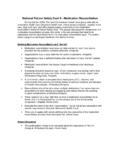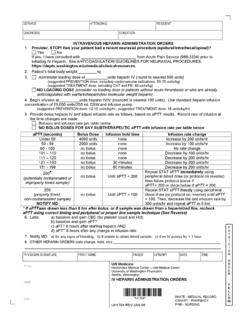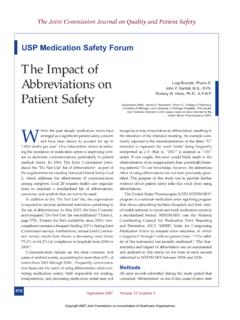Transcription of What Works for Preventing Hospital Readmissions?
1 Steven M. Riddle, BS Pharm, BCPS, FASHP Vice President of Clinical Affairs Pharmacy OneSource/ Wolters Kluwer Health Clinical Affiliate Professor, UW School of Pharmacy May 15, 2012 What Works for Preventing Hospital Readmissions? A review of the current evidence and best practices Objectives Describe common causes for readmissions and the patient risk factors associated with these events. Describe 3 specific service interventions that successful programs have used to reduce Hospital readmissions Explain how to build a scaleable model of services that is effective in reducing readmission and sustainable based on successful clinical and fiscally sound practices in place in the US Why All the Talk About Readmissions?
2 *MedPac 2007 Report to Congress; Promoting Greater Efficiency in Medicare. Chapter 5: Payment Policy for Inpatient Readmissions Poor care coordination and use of evidence-based approaches Large # of readmissions are preventable Quality IOM reports made clear the consequences of poor transitions management Safety CMS indicates $13B* in savings or $25B across all US payers Cost Medicare Reimbursement The Patient Protection and Affordable Care Act (HR 3590): Title III - Improve the Quality & Efficiency of Care At Risk: 1% reduction in FFY2013, Increasing to 3% FFY2015 Efficiency Measures (Section 3001) Patient Experience Measures HCAHPS (Section 3001) At Risk: 1% in FFY2013 growing annually to 2% in FFY2017 Process of Care Measures (Section 3001) readmission Reduction Program (Section 3025) Hospital Acquired Conditions (HAC) (Section 3008) 5 Value-Based Purchasing (VBP) Outcomes Measures (Section 3001) At Risk: 1% reduction beginning FFY2015 Value-based Purchasing: Carrot & Stick 5 Readmissions is all stick!
3 Year 1: FFY2012 Heart failure Myocardial infarction Pneumonia Year 3: FFY2014 COPD CABG PTCA & vascular procedures Year 4: FFY2015 Expand to other conditions 6 CMS Readmissions Reduction Program Targeted MS-DRGs and Timelines 1% FFY12 2% FFY13 3% FFY14 Reduces Medicare inpatient payments for hospitals with higher than expected risk-adjusted 30-day readmission rates for certain conditions. 7 DRG Penalty Calculations HF AMI PNE # of Patients Treated with MS-DRGs 500 200 800 Number of Readmissions 142 45 158 Risk-Adjusted Readmit Rate US 30-Day readmission Rate Predicted/Expected Ratio P/E Ratio - 1 Total Medicare DRG Operating Payments $1,500,000 $775,000 $2,150,00 Excess Payment Amount $231,000 $110,000 $151,000 Total Excess Payment ($ at risk) $492,000 The Fiscal Impact of Readmissions.
4 CMS Readmissions Reduction Program Total Medicare DRG Payments Max Capped Penalty Rate Amount at Risk $60,000,000 1% (FFY12) $600,000 $60,000,000 2% (FFY13) $1,200,000 60,000,000 3% (FFY14 $1,800,000 Penalty for Future DRG Admits FFY13 $492,000 / $600,000 = Focus on cost efficiencies Capitated Care or MSSP (ACO) EPISODE OF CARE payment includes 30-days post-discharge Bundled Payments for Episodes of Care Customer selection Payer contracts Public Reporting admission not an issue FFS model still in place Cost of launching new programs for HRRP Hospital Barriers Other Drivers & Considerations with Readmissions Examine your Hospital s current performance Assess and prioritize your improvement opportunities Develop an action plan of strategies to implement Monitor your progress Action Steps to Improve Quality around Readmissions To Fix It You Have To Know Whats Wrong!)
5 Understanding YOUR Readmissions Problems 10 What are your Hospital s rates for readmissions? Remember that your internal data will not capture readmissions to other hospitals! Who is coming back in? Why are they coming back? Data Sources Internal data Source: Quality, Finance, COO, etc External Sources 3rd parties and payers Data content considerations Rates based on conditions Rates based on key causes (ie, medication-related events) Rates per practitioner Rates by readmission source (home, SNF, NH) Rates per time intervals (7, 15, 30 and 90 days) System Analysis of the readmission Problem 12 Complex Analysis (Based on Project RED from Boston Univ.)
6 MC) Simple Analysis (IHI STAAR Toolkit) charts of 5 recent readmissions (abstraction tool) patient/family of 5 current readmissions 5 discharge teaching events Goal is to look for trends, gain insights, challenge assumptions and gain data for deeper evaluations as needed. High-Level Strategies for Readmissions and Improving Continuity of Care IHI STAAR Initiative State Action on Avoidable Rehosptilizations Planning/Risk Assessment Med Rec Perform Enhanced Admission Assessment for Post- Hospital Needs Customize education Teach-back technique Provide Effective Teaching and Enhanced Learning Med Rec Customized care plan Conduct Real-Time Patient & Family-Centered Communication Follow-up based on risk Ensure Post- Hospital Care Follow-Up The Care Transitions Program Medication Discrepancy Tool (MDT)
7 Medication self-management Use of a dynamic patient-centered record Primary Care and Specialist Follow-Up Patient Knowledge of Red Flags Project BOOST Better Outcomes for Older Adults through Safe Transitions Patient Centeredness Patient Empowerment Risk Appropriateness Team Oriented Bridging System Strategies for Reducing Readmissions Develop a system-level approach that is both effective and sustainable Focus on readmissions that are truly avoidable! Goal Care transition focused Team-based approach Patient-centered Strategy Which interventions have the greatest impact? What is the best timing for interventions?
8 Which staff can best address the needs? Questions 18 Examining Interventions/Programs to Reduce Readmissions Trial Population: 749 hospitalized adults at urban teaching Hospital Description of Intervention: Inpatient via nurse discharge advocate (DA) Educate patient on diagnosis and condition management Make and coordinate post-discharge appointments and testing Discuss lab or study results and needed follow-up Confirm medication plan (reconcile, educate, access) Align care plan with protocols, policies and EBM Transmit discharge summary to stakeholders Assess patient understanding of care plan (using teach-back) Post-Discharge Care Plan (via DA) Provide patient written after- Hospital care plan ( AHCP ) Post-Discharge Telephone Component (via pharmacist)
9 Call patients 2 to 4 days after discharge to reinforce the discharge plan, review medications and solve problems Project RED (MA) Timing/Location Admit, Discharge, Post-Discharge Service Care plan, medication management Key Players RN discharge advocate (DA), Pharmacist Citation: Jack et al. A Reengineered Hospital Discharge Program to Decrease Rehospitalization. Ann Intern Med. 2009;150:178-187. Results: Project RED Citation: A Reengineered Hospital Discharge Program to Decrease Rehospitalization. Ann Intern Med. 2009;150:178-187. Intervention Cost Total = $149,995 $412 savings per person (NNT = 7) lower observed cost compared to standard care group Timing/Location Admit, Discharge, Post-Discharge Service Care plan, medication management Key Players RN discharge advocate (DA), Pharmacist ED Use/Readmissions 30% reduction Participants Control visit per person per month [95% CI, to ]; P ).
10 Cumulative hazard rate of Hospital utilization for 30 days after index Hospital discharge Project RED Citation: A Reengineered Hospital Discharge Program to Decrease Rehospitalization. Ann Intern Med. 2009;150:178-187. Timing/Location Admit, Discharge, Post-Discharge Service Care plan, medication management Key Players RN discharge advocate (DA), Pharmacist Pharmacy Interventions Median total pharmacist time per participant = 26 minutes. Total weekly pharmacist time (following 14 participants per week) = hours ( FTE) Successfully contacted 228 (62%) of the intervention participants Completed medication review with 195 (53%) participants.






